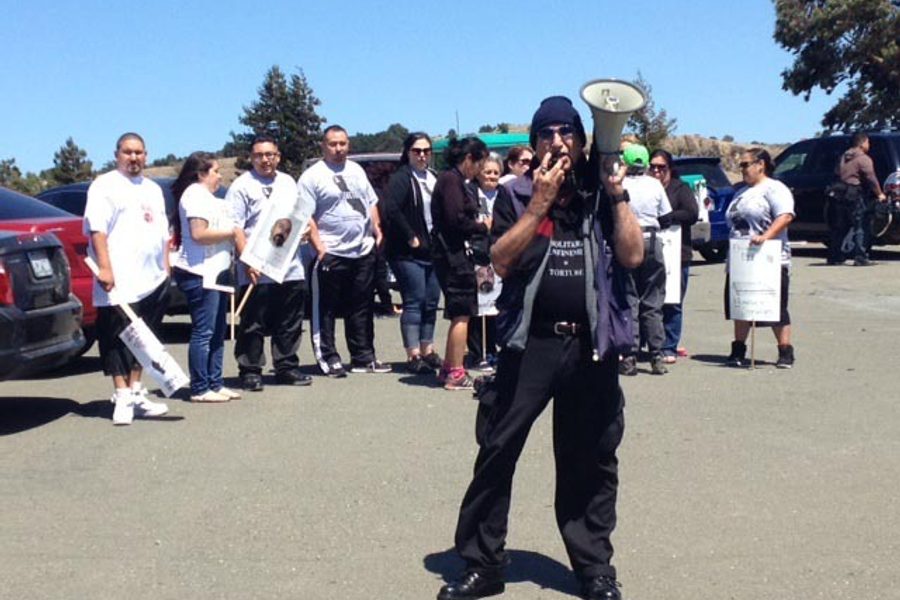
Family members of hunger striking prisoners joined a demonstration outside San Quentin State Prison on Saturday. In the third hunger strike since 2011, hundreds of prisoners have been on strike for 31 days to protest long-term solitary confinement. Medical officials say several prisoners have been seen by staff in recent days with health issues, including dehydration, arising from the strike.
“My son is behind those walls back there, but I feel real good that he knows I’m out here,” said Juanita Topete, pointing to the prison. She added that she felt proud to be taking part in a protest “representing all the prisoners, and all the families, who are going through the torturous ordeal of not being able to hug their sons, of seeing their sons deteriorate in solitary confinement.”
Demonstrators held tightly onto banners that read “Stop the Torture” and “Support the Hunger Strikers” as they were blown about by a strong wind.
Tiffanie Palacios, also at the rally, said her “primo,” Antonio “Chuco” Guillen, was one of four prisoners who originally put out the call to strike in 2011. Palacios came to San Quentin on Saturday along with Guillen’s wife, sister and kids “to support the rest of the hunger strikers, fighting for what they deserve: not to be treated like dirt.”
Prisoners in solitary confinement are not allowed to use the phone but, “they have a voice out here, and that’s us,” says Palacios.
They also have the Prisoner Hunger Strike Solidarity Coalition, a group of several organizations that staged the rally and provides other outside support. Laura Magnani, of the American Friends Service Committee, has been involved in the coalition since word first reached her in 2011 that prisoners in Pelican Bay State Prison were planning a hunger strike. “They sent out word that they really needed the community to back them up,” says Magnani “and that they needed strong activism on the outside at the same time.”
An eight-person team chosen by the prisoners, which Magnani is part of, also serves as a “voice” for the hunger strikers to advocate on their behalf with corrections officials. Despite the insistence of corrections officials that the department does not negotiate with prisoners, Magnani says the team played an important role in helping bring about an end to the second hunger strike in 2011. After getting a written proposal for reforms from the department, the team was allowed to speak by phone with some of the prisoner representatives, who agreed to the terms and called off the strike.
On Friday, Magnani and the rest of the team met with Corrections Secretary Jeffrey Beard himself for the first time since the current strike began. The meeting was “very cordial,” according to Terry Thornton, a spokesperson for the Department of Corrections and Rehabilitation. “He listened to their concerns, answered questions and explained the changes that have taken place in Security Housing Units over the past two years,” said Thornton. For their part, the eight-person team of advocates said in a statement, they proposed changes at the meeting “intended to create more humane conditions and circumstances.” Thornton said their proposals would “be taken into consideration.”
Under the watch of San Quentin’s guards, demonstrators on Saturday listened as speaker after speaker shared their stories of solitary confinement. A small boy carried a hand-made sign that read “I’ve never hugged my Dad.” As the hunger strike has gone on, family members have organized protests, vigils, and delivered petitions to the governor’s office.
A petition on Change.org started by Mayra Romero, whose husband, Juan, is held in solitary confinement, had more than 80,000 signatures as of Monday. Family members have also played a significant role in bringing other organizations to the cause. After Yulisa Elenes told fellow members of Unite Here Local 2850 about her brother’s incarceration, the union voted to support the demands of the hunger strike. “He’s my little brother, my only brother,” says Elenes, who serves as secretary-treasurer for the union. “The whole family is locked up.” To Elenes, the hunger strike is a labor issue, because unions should be “fighting for better conditions whether they’re at work, or in jail.” The local represents 2,000 workers in the hotel, gaming, and food service industry in the north and east of the San Francisco Bay.
Behind the scenes, other unions with ties to Governor Jerry Brown have privately written to him asking him to take action to end the strike. Magnani says she is hopeful that pressure from unions “who have been so financially crucial to the governor “will help persuade him to take action.
Magnani believes that the range of groups involved in the coalition is helpful “because it shows that it’s not just the usual suspects like us.” She pointed to statements of support from community and religious organizations, as well as “An Open Letter to Governor Brown” being circulated online. Among the signatories to that letter are entertainer Jay Leno, actor Susan Sarandon and linguist Noam Chomsky. The letter says that, along with more than 1,000 others, they “stand together against these shameful practices and consider them extensions of the same inhumanity practiced at Abu Ghraib and Guantanamo Bay.”
Prison officials maintain that the strike is being organized by prison gang leaders, but supporters say that’s untrue. Thornton said that the corrections department will “continue to keep the lines of communication open” and said she was “hopeful” that the prisoners would “call off this dangerous and disruptive hunger strike.”
Outside San Quentin, Tiffanie Palacios said that she also hoped the hunger strike would end — but with the department meeting the demands of the prisoners. Standing within sight of the prison’s watchtowers and barbed wire fences, she said her family and others would continue to demonstrate “whether it’s here, whether it’s Pelican Bay whether it’s Corcoran, whether it’s Solano, anywhere they’re at, we’ll stand in support together.”


